by California Casualty | Firefighters |
Jeff Bryan is a firefighter who doesn’t let adversity keep him down. Jeff returned to full time work in March 2015, just slightly less than a year after his right leg was amputated below the knee. Jeff severely injured that leg in a 1991 skiing accident in Colorado. He “limped by” in pain until doctors determined the leg had to be removed. Jeff, who is a firefighter and EMT Intermediate with the Ute Mountain Fire Department in southwest Colorado, refused to let the amputation keep him down. He was released from the hospital on his 50th birthday. He says there were two ways to go: give up and feel sorry for himself or push forward and beat it – he chose to move beyond and conquer it.
As soon as he was able, he started bicycling, ice climbing, paddle boarding, swimming and yoga. As far as anyone can determine, Jeff is the only firefighter in Colorado to return to full-time active duty after a leg amputation. Jeff does not want to be known as the firefighter who lost a leg, but the guy who works hard to stay in shape and be the best EMT/firefighter he can.
What’s his philosophy and how does he train? He spells it out here in his own words:
In 1991, I suffered a commuted fracture of my tibia while skiing in Breckenridge, CO. It was during this injury that I first trained to get my life back.
In 2011 I had an ankle replacement. I once again undertook the task of regaining my fitness; however, I never regained my top physical condition. For the next 3 years I worked in unbearable pain. I basically, worked, slept and trained in the gym. I developed high blood pressure. I was getting sick.
On March 20, 2013 I worked a 72. On the 23rd I clocked out and headed to Vail to meet my doctors. Four days later, I was told my best option was amputation. I spent the next three days lying in bed. During this time I made the decision that failure was not an option.
On April 22, 2014 I had a below the knee amputation. I went for an Ertl amputation since I qualified. The Ertl procedure is designed to build muscle and preserve bone that will support prosthetic devices for those who plan to be active. The surgery went well and I was released from the hospital 4/26, my 50th Birthday.
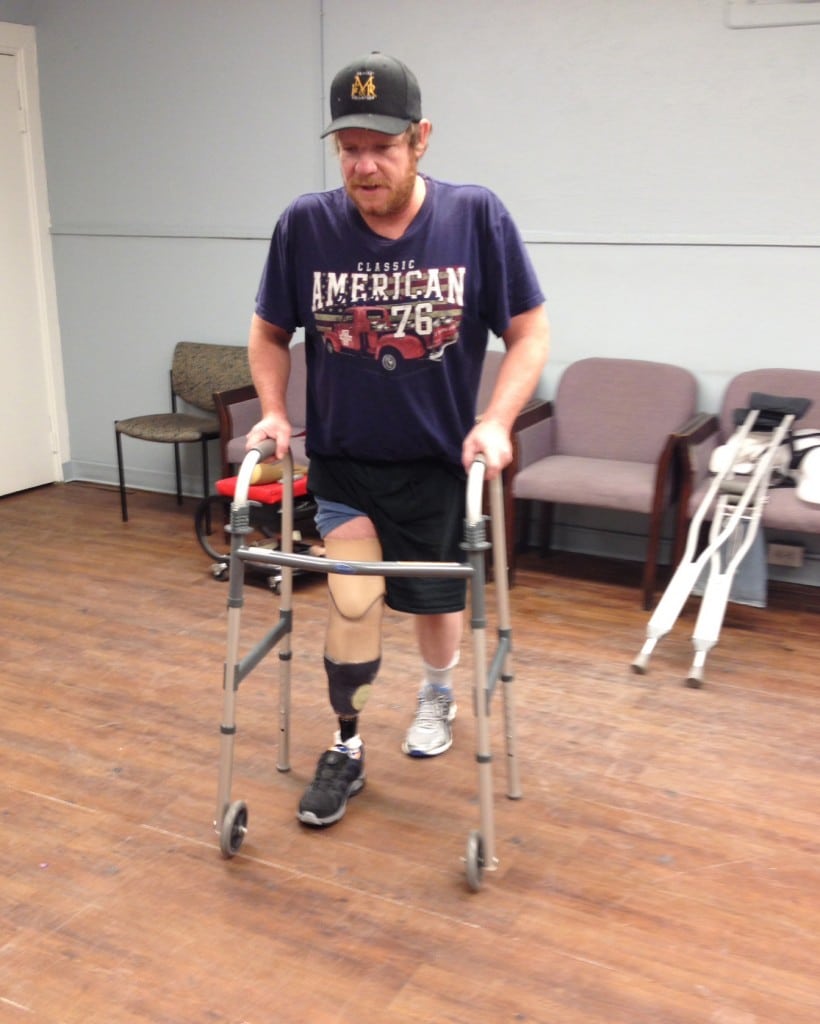
Now 30 pounds overweight, I had a huge undertaking. I needed to lose the 30 pounds and fulfill my goal of returning to active duty. 50 years old, overweight and now an amputee!
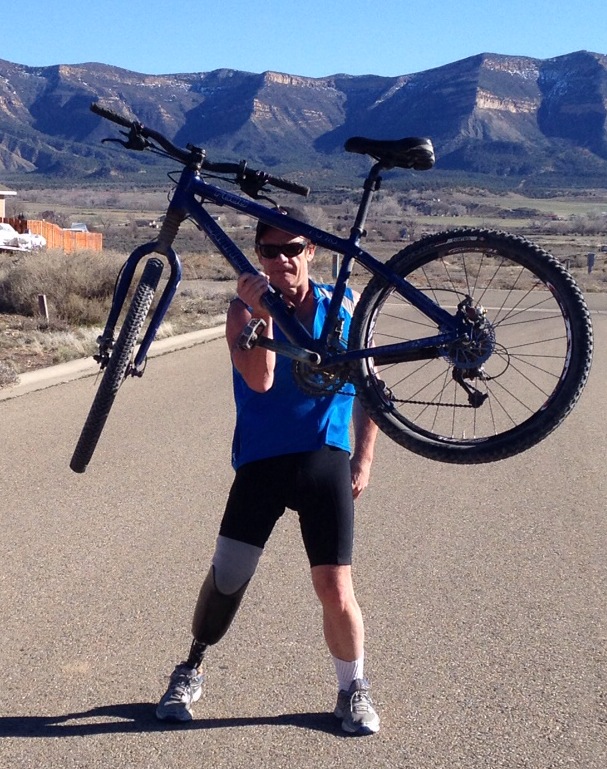
I started out just the way I did in 1991. At four weeks I started riding the bike with one leg. At six weeks I received my first prosthetic and was on my way to PT. I followed my instructions to a tee. I continued to bike and work on balance. At this time I also started yoga.
At my age I did not need to increase my calorie intake above 2000 calories a day. I eat a balanced diet, consisting of plenty of fruits and vegetables, chicken and grass fed beef, which I purchase by the half cow. Once a week I splurged and enjoy a bowl of Ice cream. I drink water, 10-12 glasses a day. I never drink soda.
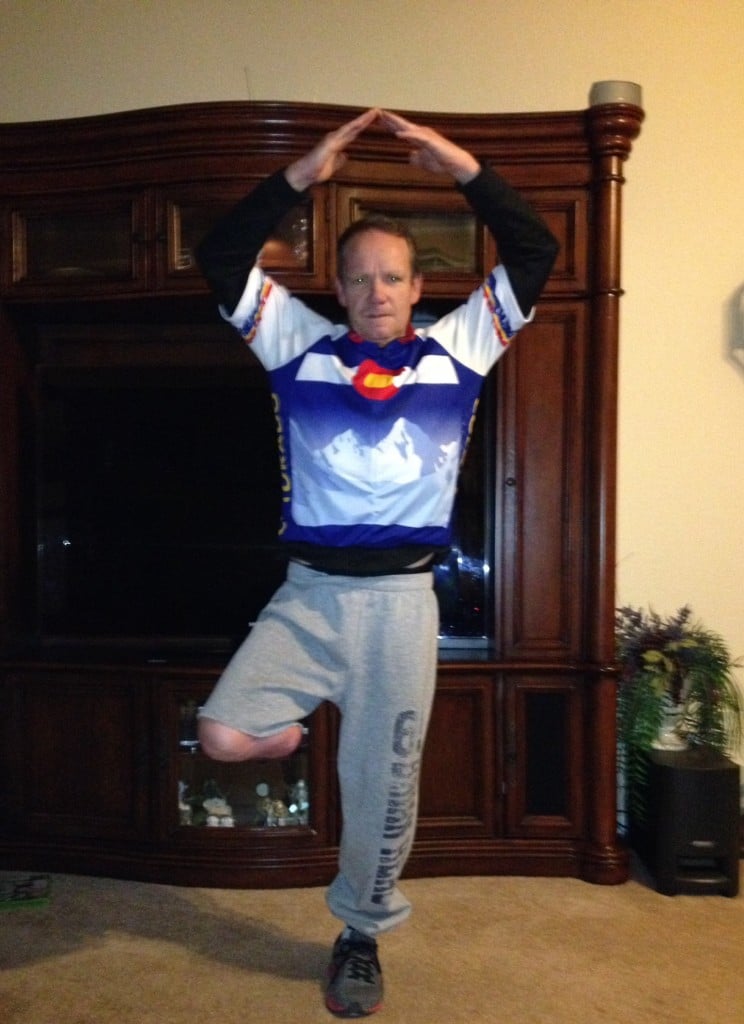
Within a week of getting my first prosthetic I went out on my stand up paddle board. I spent a lot of time swimming, paddling, spinning and lifting. I am a firm believer in high reps, low weight.
We all hear the term crossfit. I do not do a crossfit program. I am a firm believer in cross training, consisting of cardio, core, flexibility and strength training. As I progressed, I started to add new activities. In July, I started rock climbing. In August, I started biking outside.
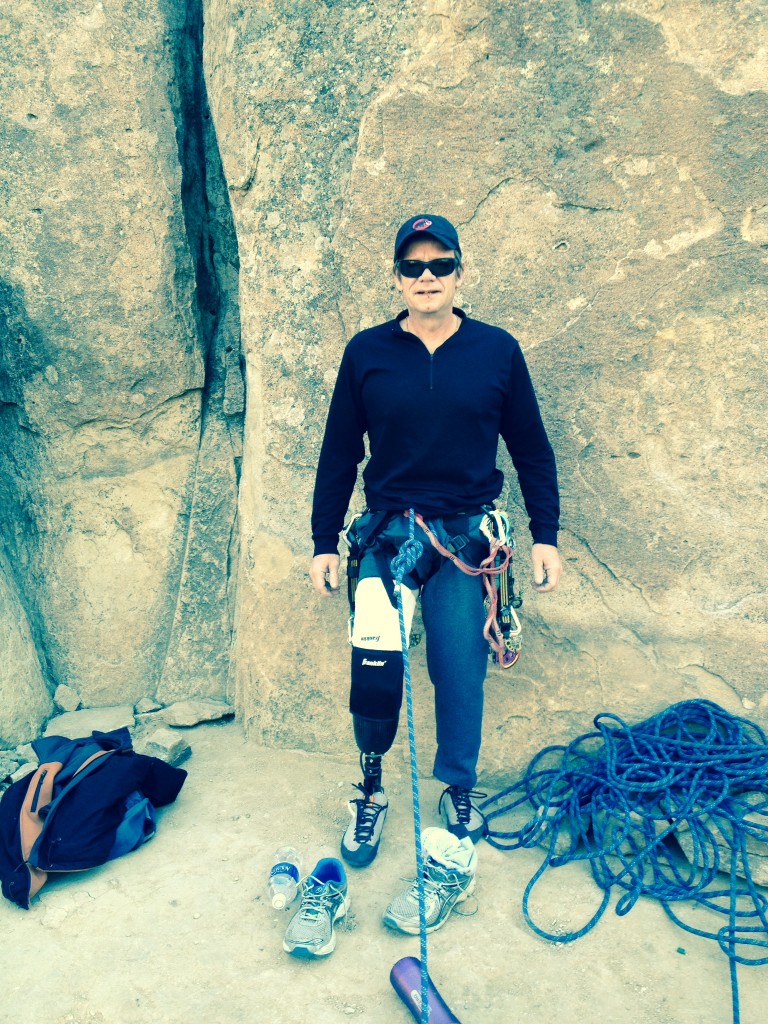
At 50 years old, avoiding injury is key. Yoga or a good stretching routine should be done daily. Cardio should be done a minimum of three days a week. I prefer four or five, but three will work. I do weight training four days a week. All my weight lifting is done either after cardio or after I ride my bike to the gym. I never lift heavy. I keep my reps at a minimum of 12. I usually do sets of 16-24. I lift for endurance, strength and elongated muscle. Heavy lifting will not only decrease flexibility, it will Increase your risk of injury.
The idea is to move fluidly between cardio and strength while resting as little as possible. As I progressed I added more activities. I started to climb ice, backcountry ski, bike hard and stick to my routine. The idea is to mix it up and have fun.
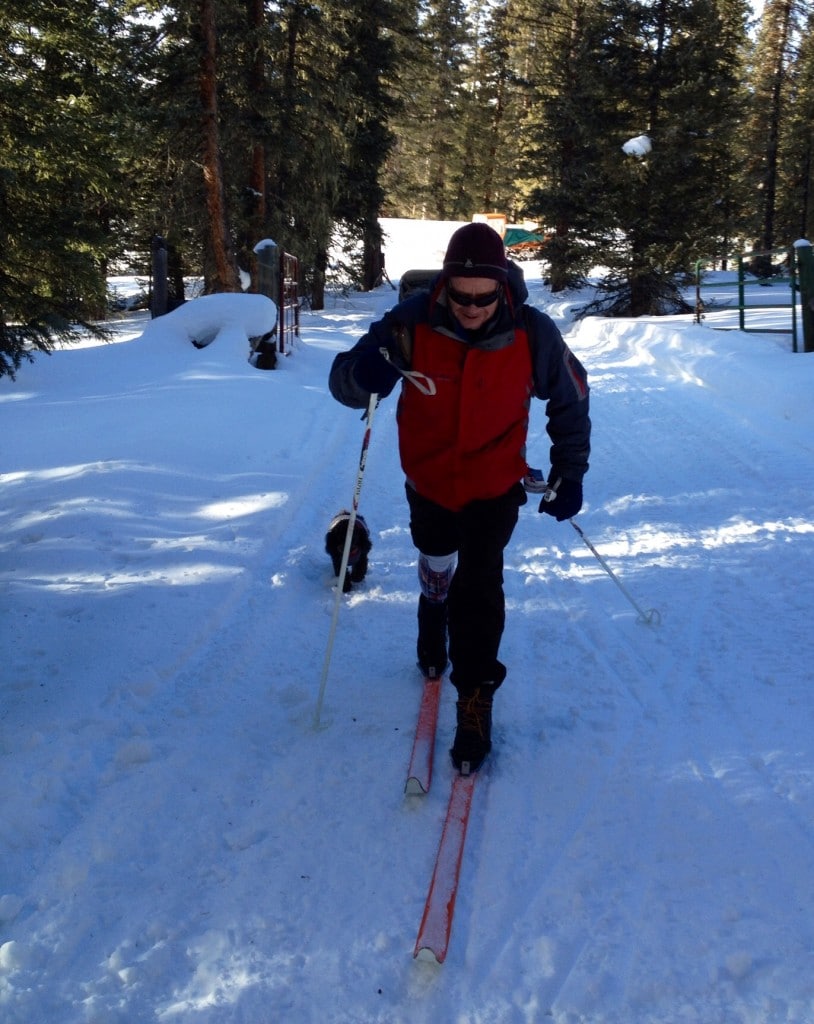
In January I started ice climbing again. I was climbing strong and climbed as much as I could. I started riding single track on my mountain bike in March. I mix it up as much as possible. Your workout should not be a chore, it should be fun. If you’re not having fun, try something different. Start slow and increase your intensity. I add weight very gradually. I make sure I can do a set of 24 before I up my weight. My bike rides started out at five miles. I am now averaging about 25 per ride on my road bike and 10 miles a day on single track. Just remember Cardio, Core, Flexibility and Strength.

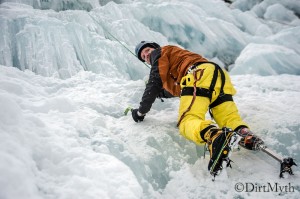
As the seasons change, I take advantage of the weather. I cross country ski, climb, bike or paddle. I still do a minimum of four days lifting; once again, never with heavy weight. I am a true believer that flexibility, elongated muscle, core strength and endurance is the key, especially for firefighters and first responders (more on that in coming articles).
And, all this is working. At nine months I was cleared for full duty by my doctor. At 11 months, I had cleared my final physical. In March, I returned to full duty as a line firefighter and my first shift was 3/7/15.
*Note- Jeff completed the first 30 days of his 90 day probation on April 7 without any issues. He is committed to being the best first responder he can, serving the Ute Mountain Ute Tribe of Southwest Colorado.
by California Casualty | Firefighters, Health |
Few jobs are more stressful on a daily basis than being a firefighter. Not only must you deal with dangerous situations, but you’re also required to stay healthy and fit.
Whether you’re facing hectic hours and demanding duties that leave you tired at the end of the day, or spending long hours doing little but wait for a fire or medical emergency call, it’s essential for you take care of your body so it can keep performing well.
Diet and nutrition
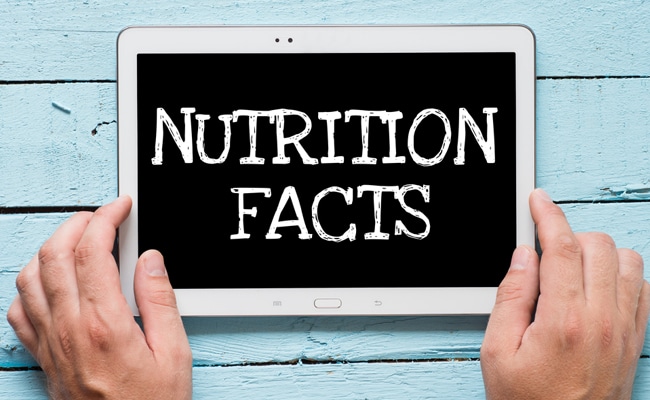
As a firefighter, it’s critical that you pay attention to what you’re putting into your body. Obviously, nutrition directly affects physical performance, and as a first responder it’s vital that you’re always in shape and ready to act.
Here’s some advice for eating right:
- Get plenty of carbs. As someone who regularly engages in strenuous physical activity, it’s necessary for you to load up your body with complex carbohydrate-rich foods (such as fruits, veggies, whole-grain products, and cereals). These items fuel your muscles and enable you to enjoy better overall performance.
- Cut back on sugars. If you have a sweet tooth, that may turn out to be your greatest weakness. That’s because foods that are high in sugar slow you down and zap your energy, which you need when responding to a demanding situation.
- Start with a good breakfast. It’s wise to start off your day with a solid first meal. While breakfast is traditionally regarded as the first meal of the day, this could vary depending on your shift schedule. Whatever you first meal is, make it substantial and give yourself sufficient fuel to cover the duration of your shift.
Exercise and fitness

You might understand the importance of staying physically fit, but you likely lack a ton of spare time to work out. The good news is that it only requires a few minutes each day.
- Try high-intensity. There are generally two schools of thought when it comes to workouts. You should either do long, low-intensity workouts, or quick, high-intensity routines. When you’re restricted by time, the latter is extremely valuable. When you commit to high-intensity workout regimens, you realistically need only 20 to 30 minutes. Even for a firefighter with long shifts, that’s reasonable.
- Find a partner. There’s always power in numbers, and you can benefit substantially by having a workout partner. Ideally, this should be someone whoworks the same shifts and has the same fitness goals as you do. You can work with this individual to develop a detailed plan and stay accountable.
- Master the ten-minute routine. Since you never know what’s coming on any given day, it’s smart to save your energy and be prepared. However, that can result in a lot of wasted time if you aren’t careful. That’s where ten-minute routines come in handy. When you’re hanging around the station, try to perform a quick 10-minute workout every hour. These routines will keep you fit without draining your energy all at one time.
Sleep and relaxation

You mustn’t forget about sleep and relaxation. The only way to prepare yourself properly for your next shift is to take advantage of your down time and refuel.
- Find a schedule. If your shifts are sporadic, it can be challenging to establish any continuity — but a schedule is important. If you find yourself lying in bed without falling asleep, get up, do something, and then return to bed after 20 minutes. Agonizing over sleep will make it more difficult to nod off.
- Watch your diet. Avoid alcohol, caffeine, and excess fluids prior to going to sleep. Having too much in your system will affect your quality of sleep and may cause disruptions through the night.
Auto insurance for firefighters
At California Casualty, we offer superior auto insurance for firefighters. We do this because we believe our local first responders deserve reliable and effective protection, too.
For more information on our various polices, or for answers to your questions, please reach out and contact us today!
by California Casualty | Homeowners Insurance Info |
Springtime is tornado season in the United States. Many people have been lulled into false sense of security by the relatively slow start this year. But once again Mother Nature flexed her muscles sending destructive storms roaring through much of the Midwest. As the cleanup of twisted metal and splintered wood continues, it’s a reminder that people in tornado prone areas need to be ever vigilant of the often deadly storms.
Are you ready? A recent survey commissioned by the Property Casualty Insurers Association of America (PCI) found 56 percent of Midwesterners consider themselves not well prepared for the aftermath of a natural disaster or severe weather.
Tornados are violent, abrupt and are often obscured by rain or darkness. Being prepared ahead of time is essential.
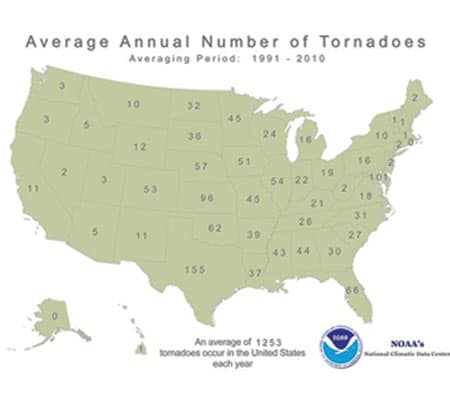
Here is important, potentially lifesaving information about tornados from Weather Underground:
- Develop an emergency plan for your family
- Know where safety shelters are located
- Monitor NOAA Weather Radio when severe weather is forecast
- Know the difference between a tornado watch and warning – a watch means conditions are right for tornado activity and people should be on alert, a warning means a tornado has been sighted and you should take shelter immediately
Here are tornado danger signs:
- Dark, greenish sky
- Large hail
- A large, dark, low-lying cloud that may be rotating
- A loud roar, often compared to a freight train
These are dos and don’ts from the American Red Cross if you are caught in a tornado:
- Do go immediately to an underground shelter, basement or safe room
- Do find a small windowless room in the interior of a home or hallway on the lowest level of a sturdy building
- Don’t stay in a mobile home unless absolutely necessary
- Do stay in your vehicle with the seat belt fastened and your head below the windows, covering your head with a blanket, coat or your hands
- Do go to a low lying area like a culvert or ditch if caught outdoors and cover your head with a coat or your hands
After a tornado:
- Continue listening to local news or a NOAA Weather Radio for updated information and instructions.
- If you are away from home, return only when authorities say it is safe to do so.
- Wear long pants, a long-sleeved shirt and sturdy shoes when examining your walls, doors, staircases and windows for damage.
- Watch out for fallen power lines or broken gas lines and report them to the utility company immediately.
- Stay out of damaged buildings.
- Use battery-powered flashlights when examining buildings – do NOT use candles.
- If you smell gas or hear a blowing or hissing noise, open a window and get everyone out of the building quickly and call the gas company or fire department.
- Take pictures of damage, both of the building and its contents, for insurance claims.
- Use the telephone only for emergency calls.
- Keep all of your animals under your direct control.
- Clean up spilled medications, bleaches, gasoline or other flammable liquids that could become a fire hazard.
- Check for injuries. If you are trained, provide first aid to persons in need until emergency responders arrive.
Some common myths associated with tornados are:
- Leave windows open to equalize pressure
- Tornados don’t hit large cities
- Tornados don’t occur in mountains
- Seeking shelter under an overpass is a safe
There is new information from recent storms that sturdy garage doors may be the best protector of a home. The study of tornado damage found wood frame homes with sturdy garage doors suffered less damage than homes with flimsy garage doors.
The research from the University of Alabama also concluded that tornado shelters – underground or above ground safe rooms – saved lives.
The researchers compared damage from major tornadoes that struck Moore, Oklahoma in 2013 to studies of similar storms that hit Tuscaloosa, Alabama and Joplin, Missouri in 2011.
Some of the conclusions:
- Flimsy garage doors proved to be a weak link, allowing pressurization that destroyed supporting walls and the roof when the garage was breached by devastating winds
- Storm shelters save lives even in the worst tornadoes
- In the areas damaged by lesser winds, the garage was often the root cause for failure of residential structures, allowing roofs and supporting walls to collapse
The study found that increased building safety standards and incorporation of more storm shelters are working to prevent some damage and save lives.
If your property suffers damage from a tornado:
- Secure the property from further damage or theft
- Contact your insurance company as soon as possible
- Inventory losses and take photos
- Save receipts of meals, purchases and hotels related to not being able to live in your home
- Be careful of unscrupulous contractors
This is also a reminder how important it is to take an inventory of your home and possessions before a disaster strikes.
Another way to protect your home is with an insurance policy review. Call a California Casualty advisor today, 1.800.800.9410 or visit www.calcas.com.
This article is furnished by California Casualty, providing auto and home insurance to educators, law enforcement officers, firefighters and nurses. Get a quote at 1.800.800.9410 or www.calcas.com.
Resources for this article:
https://www.nws.noaa.gov/om/severeweather/resources/ttl6-10.pdf
https://www.redcross.org/prepare/disaster/tornado
https://www.wunderground.com/resources/severe/tornado_safety.asp?MR=1
https://www.pciaa.net
https://esridev.caps.ua.edu/MooreTornado/Images/MooreTornadoFinalReport.pdf
by California Casualty | Auto Insurance Info |

The changing of the seasons is nice; the heat is replaced by crisp, cool air, we can dig out our favorite sweaters and hoodies and most of us can stop mowing the lawn. However, there is one part of the upcoming winter that I’m dreading – that first storm of the year that starts warm but chills down so quickly it turns sleet and melted snow into a glaze of ice. Traffic will be snarled as drivers with worn tires try to navigate around town. We’ll know the ones who haven’t checked their tire tread; they’ll end up slipping and sliding, causing accidents and clogging major thoroughfares. It happens every year, and if you’ve never seen it yourself check out this video (be aware it does contain some adult language).
And that’s in Colorado, where people should know about having the right tires for winter conditions.
Before you lose your grip this winter, make it a point to have your tires checked. They are the essential piece that keeps your vehicle on road surfaces, protecting you and your children, even when streets become slick with snow and ice.
How do you know which tires will give you the best grip and control when temperatures plunge and roadways freeze? Consumersearch.com analyzed owner reviews and expert tire tests from around the world to come up with its four best snow tire picks for 2015:
- Bridgestone Bizzak WS80 (best winter tire)
- Nokian Hakkapeliitta 8 (best studded snow tire)
- Michelin Pilot Alpin PA4 (best winter performance tire)
- Michelin Latitude X-IceXi2 (best winter tire for SUVs and trucks)
Consumer reports also rated numerous all-season tires for best winter performance and recommends:
- Michelin Defender (all-season)
- Continental PureContact (performance all-season)
- Michelin Ice X13 (winter)
Treading Lightly
Many of us wonder if the tires on our vehicles have enough rubber for treacherous conditions. One determiner is the penny test. Car experts say using simple coins can determine how much tread is left on your tires.
Take It Easy
The Weather Channel says no matter what type of vehicle you drive or the tires you choose, staying off roads in severe winter conditions is your best bet. If you must travel, they offer these safety tips:
- Decrease speeds and leave plenty of room to stop
- Brake gently to avoid skids
- Turn on lights and keep lights and windshields clear and clean
- Use low gears to keep traction
- Be especially careful on bridges, overpasses and infrequently traveled roads that are likely to ice up quickly
- Keep an emergency kit in your vehicle
Let’s face it, even in the best weather conditions accidents happen. Don’t be skating on thin ice when it comes to insurance – make sure your auto insurance policy offers the best protection at the best value. Call a California Casualty advisor today for a free, no hassle policy review and comparison at 1.800.800.9410; the savings could warm your heart and pocketbook.
Sources for this article:
https://www.youtube.com/watch?v=AX_KyLuhdDQ
https://www.consumersearch.com/snow-tires
https://www.consumerreports.org/cro/tires/best-and-worst-tires-in-all-weather-conditions
https://maps.weather.com/activities/driving/drivingsafety/drivingsafetytips/snow.html
https://www.pennytest.com/
https://www.ready.gov/car
https://www.fema.gov/media-library-data/1408633655071-32caae446efef4ab2f4fcccdb55f725c/PrepareAthon_WINTER%20STORMS_HTG_FINAL_508.pdf
by California Casualty | Nominate a Hero |
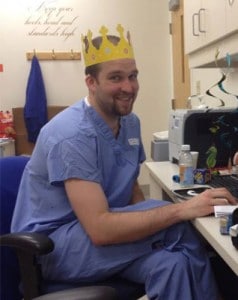
Some say Steve is just a ‘young pup” as a nurse, and still learning what an impact he has on others. Co-workers say that he takes great pride in teamwork and is the go-to man to help out. Patients of all ages seem to gravitate to his fun personality. He serves as a volunteer staff nurse for Camp Braveheart, a week long camp for YMCA for kids.
He also created and implemented the Friend Advocate Nurse Program, which helps pair a RN with each patient for support, creating a friendly safe connection for the patient. Friends say he often mentions that he wants to be more than average at things. They also say he is the type of person to always be there with staff growing and learning, keeping a positive spin and smiling brightening everyone’s day.













